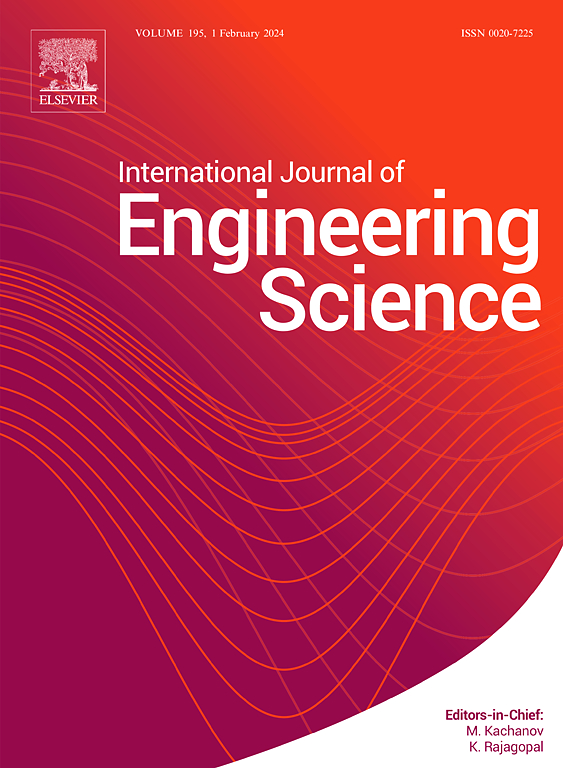骨小梁支架新型支撑物辅助元生物材料研究
IF 5.7
1区 工程技术
Q1 ENGINEERING, MULTIDISCIPLINARY
International Journal of Engineering Science
Pub Date : 2025-06-02
DOI:10.1016/j.ijengsci.2025.104316
引用次数: 0
摘要
该研究提出了一种新型的高多孔、仿骨的仿生元生物材料,作为增材制造的钛骨科植入物的骨小梁支架。这里提出的晶格结构的基本单元由基于支柱的棱柱状小梁单元组成,在它们的角落由手性韧带连接。通过分析模型和有限元模拟,我们评估了所研究的生物设计的准静态有效力学性能,揭示了这些元生物材料具有广泛的孔隙度,杨氏模量和类似于人类骨骼的屈服应力,特别是椎体松质骨组织。开发的分析和计算模型考虑了Euler-Bernoulli和Timoshenko光束理论来估计超生物材料的性质。我们还表明,这些晶格模型对于基本单元的特定几何构型具有横向各向同性,并且具有广泛的负泊松比。此外,还推导并给出了这种晶格的弹性特性作为其单元胞拓扑的函数的解析表达式。然后使用增材制造技术在聚合物材料中制造出所提出的晶格结构的物理原型,并进行实验测试以评估其增减潜力,从而验证我们的分析和计算预测。总的来说,我们的研究结果表明,这些新型的元生物材料具有相对低的弹性模量和高孔隙率的组合,可以潜在地减少应力屏蔽现象,同时促进骨在其中的生长。这项工作的初步发现为在脊柱肿瘤学中用于增材制造金属椎体植入物和装置的轻质辅助晶格的发展提供了新的见解。本文章由计算机程序翻译,如有差异,请以英文原文为准。
Towards new strut-based auxetic meta-biomaterials for trabecular bone scaffolds
The work proposes new highly porous, bone-mimicking auxetic meta-biomaterials as trabecular scaffolds for additively manufactured titanium orthopedic implants. The elementary cell of the lattice architecture proposed here consists of strut-based prismatic trabecular units connected by chiral ligaments at their corners. Through an analytical model and Finite Element simulations, we evaluate the quasi-static effective mechanical properties of the investigated bio-designs, revealing that these meta-biomaterials exhibit a wide range of porosities, Young’s moduli, and yield stresses similar to those of human bones, and particularly, vertebral cancellous bone tissues. The developed analytical and computational models consider both the Euler-Bernoulli and Timoshenko beam theories to estimate the meta-biomaterial properties. We also show that these lattice models possess a transverse isotropic property for a specific geometric configuration of the elementary units, and a wide range of negative Poisson’s ratios. In addition, analytical expressions for the elastic properties of such lattices as a function of their unit cell topology are derived and presented. A physical prototype of the proposed lattice architecture is then fabricated using additive manufacturing, in polymeric material, and experimentally tested to assess its auxetic potential, thus validating our analytical and computational predictions. Overall, our results demonstrate that these novel meta-biomaterials exhibit a combination of relatively low elastic moduli and high porosity values that potentially reduce the stress-shielding phenomena while promoting the bone ingrowth within them. The preliminary findings of this work provide new insights into the development of lightweight auxetic lattices for additively manufactured metallic vertebral implants and devices in the spinal oncology.
求助全文
通过发布文献求助,成功后即可免费获取论文全文。
去求助
来源期刊

International Journal of Engineering Science
工程技术-工程:综合
CiteScore
11.80
自引率
16.70%
发文量
86
审稿时长
45 days
期刊介绍:
The International Journal of Engineering Science is not limited to a specific aspect of science and engineering but is instead devoted to a wide range of subfields in the engineering sciences. While it encourages a broad spectrum of contribution in the engineering sciences, its core interest lies in issues concerning material modeling and response. Articles of interdisciplinary nature are particularly welcome.
The primary goal of the new editors is to maintain high quality of publications. There will be a commitment to expediting the time taken for the publication of the papers. The articles that are sent for reviews will have names of the authors deleted with a view towards enhancing the objectivity and fairness of the review process.
Articles that are devoted to the purely mathematical aspects without a discussion of the physical implications of the results or the consideration of specific examples are discouraged. Articles concerning material science should not be limited merely to a description and recording of observations but should contain theoretical or quantitative discussion of the results.
 求助内容:
求助内容: 应助结果提醒方式:
应助结果提醒方式:


